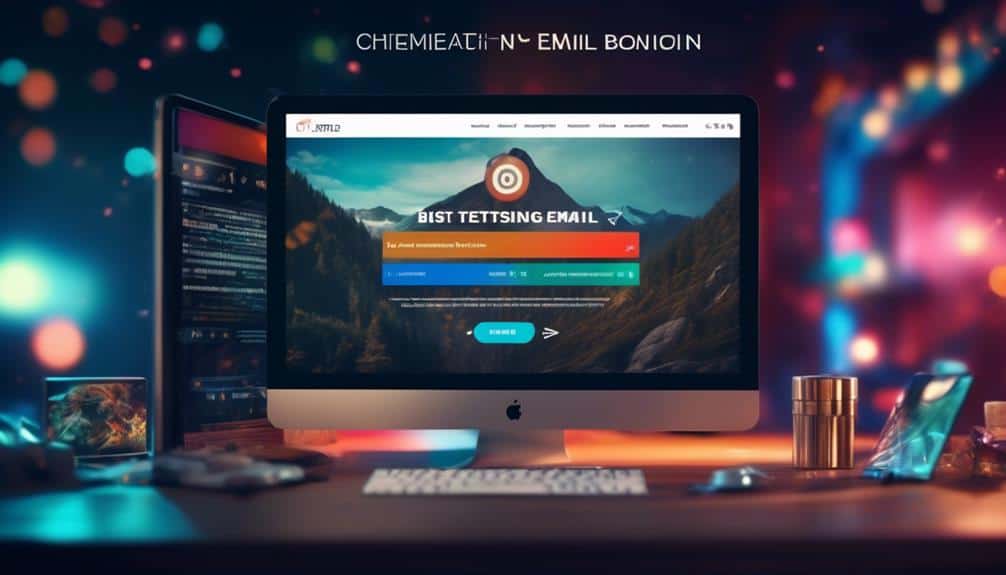Quick Action Required: Elevate Your Email Strategy With Proven A/B Testing Tips
Are your email campaigns not delivering the results you desire? It's time for quick action. Elevate your email strategy with proven A/B testing tips.
In order to optimize your email performance and drive better engagement, you need to take a data-driven approach. A/B testing allows you to compare different elements of your emails and identify what resonates best with your audience.
But where do you start? Which elements should you test? And how do you analyze and interpret the results?
This discussion will provide you with the answers you need to take your email strategy to the next level.
Key Takeaways
- A/B testing is crucial for optimizing email strategy and driving measurable results.
- Carefully select elements to test based on previous test results or goals, and prioritize them for impact on campaign performance.
- Set clear goals and metrics to focus testing efforts and measure effectiveness, such as increasing open rates, click-through rates, or conversions.
- Continuously iterate and make improvements to email strategy based on A/B test results and data-driven insights.
The Importance of A/B Testing

A/B testing is crucial for optimizing your email strategy and driving measurable results. It allows you to experiment with different variables and identify what works best for your audience. The importance of A/B testing can't be overstated when it comes to serving your customers effectively.
By testing different elements of your email campaigns, such as subject lines, call-to-action buttons, or even the timing of sending, you gain valuable insights into what resonates with your audience. This data-driven approach helps you make informed decisions and refine your email strategy for maximum impact.
A/B testing best practices involve testing one variable at a time to accurately measure its impact. Whether it's testing different subject lines to see which one generates higher open rates or testing different email layouts to determine the best conversion rate, A/B testing helps you optimize your email campaigns based on real-time feedback.
Selecting the Right Elements to Test
To effectively optimize your email strategy through A/B testing, it's essential to carefully select the elements that you'll test. Choosing the right elements to test can greatly impact the success of your email campaigns. One important factor to consider is testing frequency. It's crucial to find the right balance between testing enough to gather sufficient data and not overwhelming your audience with too many variations. Start by focusing on elements that have the potential to make a significant impact on your campaign's performance.
When selecting elements to test, it's vital to prioritize based on their potential impact. Look for elements that have shown promising results in previous tests or those that align with your goals and objectives. For instance, if you want to improve your email open rates, you might consider testing subject lines, pre-header text, or sender names. Alternatively, if your goal is to boost click-through rates, you could test different call-to-action buttons or email layout designs.
Measuring the impact of your A/B tests is crucial to determine their effectiveness. Keep track of key performance metrics such as open rates, click-through rates, and conversion rates. Analyze the data to identify which variations yielded the best results and use those insights to inform future testing strategies.
Setting Clear Goals for Your Tests

Setting clear goals is essential for effective A/B testing of your email strategy. Before diving into testing different elements, it's crucial to define your objectives. What do you want to achieve? Do you want to increase open rates, click-through rates, or conversions? Clearly outlining your goals will help you focus your testing efforts and measure the effectiveness of your strategies accurately.
Defining objectives allows you to set benchmarks for success and track progress over time. It enables you to identify which elements are working and which ones need improvement. For example, if your goal is to increase open rates, you can test different subject lines to see which one resonates best with your audience. If your goal is to improve click-through rates, you can test various call-to-action buttons or placement within your email.
To measure the effectiveness of your tests, utilize key performance indicators (KPIs) such as open rates, click-through rates, conversion rates, and revenue generated. By comparing the performance of different versions of your emails, you can gain valuable insights into what works and what doesn't. This data-driven approach ensures that your email strategy is optimized to deliver the best results.
Designing Effective Test Variations
Once you have clearly defined your objectives and established your testing goals, you can now focus on crafting effective variations for your email tests. Designing test layouts and optimizing test elements are essential steps in ensuring the success of your A/B testing strategy. Here are five tips to help you create impactful test variations:
- Simplify your design: Keep your layout clean and uncluttered to make it easier for recipients to navigate and understand your message. Use clear headings, concise copy, and strategically placed call-to-action buttons.
- Experiment with color and imagery: Test different color schemes and images to see how they impact engagement. Use colors that evoke the desired emotions and choose images that resonate with your target audience.
- Personalize your content: Tailor your email content to the recipient's interests and preferences. Use dynamic content and personalized subject lines to make your emails feel more relevant and engaging.
- Optimize your call-to-action: Test different wording, placement, and design of your call-to-action buttons to maximize click-through rates. Use compelling language and make sure the button stands out visually.
- Test different email lengths: Experiment with shorter and longer emails to see how they perform. Some audiences may prefer concise messages, while others might respond better to more detailed content.
Conducting A/B Tests Properly

When conducting A/B tests, ensure that you follow proper protocols and methodologies to obtain accurate and actionable results. To achieve the best outcomes, it's important to adhere to industry best practices and avoid common mistakes.
Firstly, clearly define your goals and metrics before starting the test. This will help you measure the impact of different variations accurately.
Secondly, make sure to test only one variable at a time. Testing multiple variables simultaneously can lead to confusion and make it difficult to determine the true cause of any changes in results.
Thirdly, ensure that your sample size is statistically significant. A small sample size may not provide reliable data for making informed decisions.
Additionally, it's crucial to collect and analyze data over a sufficient period of time to account for any fluctuations or seasonal trends.
Lastly, document your A/B test plan and results meticulously, as this will help you replicate successful experiments and learn from any failures.
Analyzing and Interpreting Test Results
To accurately analyze and interpret the results of your A/B tests, follow these data-driven strategies:
- Collect and organize the data: Ensure that you have all the necessary data points from your A/B tests and organize them in a structured manner. This will make it easier to analyze and draw conclusions from the data.
- Define success metrics: Clearly define the metrics that determine the success of your A/B tests. Whether it's click-through rates, conversion rates, or revenue generated, having well-defined success metrics will help you accurately interpret the data.
- Compare statistically significant results: Use statistical analysis to determine if the differences observed in your A/B tests are statistically significant. This will help you identify whether the variations you tested had a meaningful impact on your email strategy.
- Consider external factors: Take into account any external factors that may have influenced the results of your A/B tests. Seasonality, marketing campaigns, or changes in customer behavior can all impact the effectiveness of your email strategy.
- Use data visualization tools: Utilize data visualization tools to present the results of your A/B tests in a visually appealing and easy-to-understand format. This will help you communicate your findings effectively to stakeholders and make data-driven decisions.
Implementing Changes and Iterating for Success

Now that you have analyzed and interpreted your A/B test results, it's time to implement changes and iterate for success.
Testing for email success is just the first step, but by iterating and making improvements based on your findings, you can elevate your email strategy to new heights.
Don't settle for average results – use the data-driven insights from your A/B tests to make targeted changes and continuously optimize your email campaigns for maximum impact.
Testing for Email Success
For optimal email success, implement changes and iterate strategically. Testing is crucial to improving engagement and optimizing conversions. Here are five key steps to test your email strategy effectively:
- Segment and target your audience: Divide your subscribers into different groups based on demographics, preferences, or behavior to deliver more personalized content.
- Test subject lines: Experiment with different subject lines to see which ones resonate best with your audience and drive higher open rates.
- Optimize email design: Test different layouts, colors, and visuals to create a visually appealing and user-friendly email template.
- Test call-to-action (CTA) buttons: Experiment with different text, colors, sizes, and placements to optimize click-through rates and drive conversions.
- Analyze and iterate: Continuously monitor and analyze the results of your tests, and use the insights to make data-driven decisions and refine your email strategy.
Iterating for Improvement
After testing and analyzing your email strategy, it is crucial to implement changes and iterate for success in order to continuously improve engagement and optimize conversions. Continuous improvement is key to refining strategies that will resonate with your audience and drive results. By making data-driven decisions and consistently testing new ideas, you can identify what works best for your specific audience and adapt accordingly. Take a look at the table below to see how implementing changes and iterating can lead to improved email performance:
| Phase | Action |
|---|---|
| Analysis | Analyze email performance metrics and identify areas for improvement |
| Implementation | Make necessary changes and updates to your email strategy |
| Testing | A/B test the changes to measure their impact on engagement and conversions |
Elevating Email Strategy
To elevate your email strategy and achieve success, implementing changes and iterating based on data-driven decisions is crucial. Here are five key steps to improve engagement and optimize conversion rates:
- Segment your audience: Tailor your emails to specific groups based on demographics, preferences, or past behavior. Personalization increases engagement and conversion rates.
- Test subject lines: Experiment with different subject lines to see which ones grab attention and drive open rates. A compelling subject line can significantly impact email performance.
- Optimize email content: Use A/B testing to refine your email content, including headlines, body copy, and calls to action. Test different elements to find the most effective combination.
- Improve email design: Make sure your emails are mobile-friendly and visually appealing. Test different layouts, fonts, and colors to create an engaging and cohesive brand experience.
- Analyze and iterate: Continuously monitor key metrics like open rates, click-through rates, and conversions. Use these insights to make data-driven decisions and refine your email strategy for optimal results.
Frequently Asked Questions
How Long Should an A/B Test Typically Run For?
Typically, an A/B test should run for a specific duration to gather enough data for meaningful insights. Consider factors like sample size and statistical significance to determine the length of your A/B test.
What Are Some Common Mistakes to Avoid When Conducting A/B Tests?
When conducting A/B tests, it's important to avoid common mistakes. Lack of clear goals and hypotheses and testing too many variables at once can hinder your testing process and yield inaccurate results.
Are There Any Guidelines for Determining the Sample Size for an A/B Test?
To determine the optimal sample size for an A/B test, consider the statistical significance you want to achieve. Larger sample sizes generally produce more reliable results.
Can A/B Testing Be Effective for Different Types of Email Campaigns, Such as Promotional Emails or Transactional Emails?
A/B testing can be highly effective for different types of email campaigns, such as promotional or transactional emails. It allows you to optimize subject lines and open rates, and has a significant impact on click through rates.
How Can A/B Testing Help Improve the Overall Performance of an Email Marketing Strategy?
Improve your email marketing strategy by using A/B testing. It helps optimize subject lines, increasing open rates and engagement. Test different elements and analyze data to make informed decisions that serve your audience better.
Conclusion
In conclusion, implementing A/B testing in your email strategy is crucial for optimizing your campaigns. By selecting the right elements to test, setting clear goals, and designing effective variations, you can gather valuable data to make informed decisions.
Properly conducting tests, analyzing results, and implementing changes will lead to iterative success. Don't miss out on the opportunity to elevate your email strategy and drive better results through proven A/B testing techniques.
Start testing today and see the data-driven improvements for yourself.








